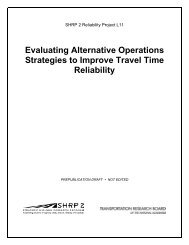Annotated Bibliography - SSTI
Annotated Bibliography - SSTI
Annotated Bibliography - SSTI
You also want an ePaper? Increase the reach of your titles
YUMPU automatically turns print PDFs into web optimized ePapers that Google loves.
Forecasting Indirect Land Use Effects of Transportation Projects,<br />
Title<br />
NCHRP Project 25‐25, Task 22<br />
Authors Uri Avins, Robert Cervero, Terry Moore, Christopher Dorney,<br />
American Association of State Highway and Transportation Officials (AASHTO) and<br />
Sponsor<br />
the Transportation Research Board<br />
Date 2007<br />
Pages 128<br />
Category Economic Development, Modes: Highway<br />
Note<br />
Online http://apps.trb.org/cmsfeed/TRBNetProjectDisplay.asp?ProjectID=1294<br />
Summary This report was prepared at the request of AASHTO to provide states with specific<br />
guidance on how to forecast indirect land use effects of transportation projects after<br />
a number of states had environmental impact statements challenged for alleged<br />
inadequate treatment of the issue. The report serves as a detailed guidebook for<br />
projecting such effects, which AASHTO determined was needed despite numerous<br />
guidance documents by states and research organizations. The authors found that<br />
the practice of predicting these effects was “a largely ad‐hoc field lacking focused<br />
guidance and research‐based understanding of land use response to transportation<br />
improvements”. Moreover where guidance was available, practitioners interviewed<br />
acknowledged skipping steps or substituting other methods.<br />
The authors point out that failure to account for this induced demand is likely to<br />
overstate travel time savings attributed to a project, which is an important part of<br />
the transportation and economic benefits. They suggest this situation adds to public<br />
skepticism about the project and its benefits and is the impetus for legal challenges.<br />
The authors also indicate skepticism about the value of “packaged models” in use by<br />
states and MPOs in considering induced travel demand and the related land use<br />
effects.<br />
The guidebook provides factors to consider in determining if indirect or induced land<br />
use effects may be promoted by the subject project. Detailed guidance is provided<br />
on how to conduct the analysis when that is determined necessary through<br />
descriptions of six types of analysis: planners’ judgment; collaborative judgment;<br />
elasticities and the potential for induced traffic; allocation models that allow land<br />
use and population forecasts to be allocated to smaller geographies; four‐step Travel<br />
Demand models with heuristic land use allocations; and Integrated Land Use and<br />
Transportation models. Of these the first three are considered foundational and are<br />
used in combination with one of the latter three for more rigor when needed due to<br />
the project’s complexity or size.<br />
<strong>Annotated</strong> <strong>Bibliography</strong> Page 2















